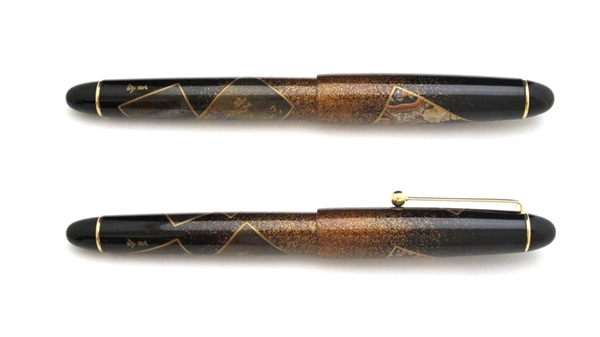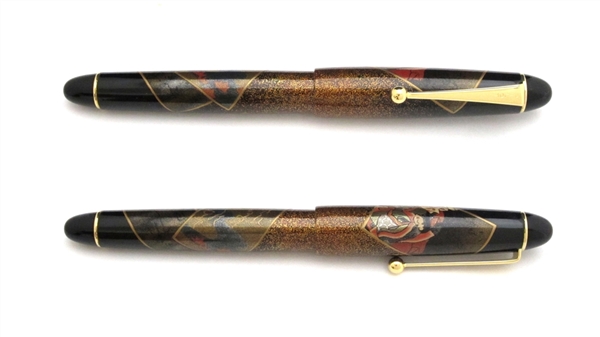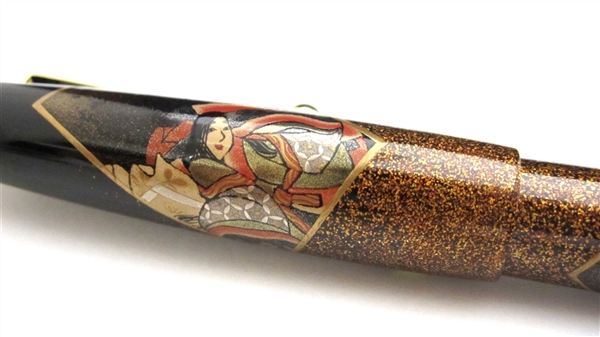AGJ Original Maki-e Fountain Pen #17 "Hyakunin Isshu" Sparkling Togidashi Taka Maki-e Kyoto Japan Wa
AGJ Original Maki-e Fountain Pen #17 "Hyakunin Isshu" Sparkling Togidashi Taka Maki-e Kyoto Japan Wa
Our Selling Price: US$1,700.00(tax excluded)
Item Description











This Authentic Goods from Japan's Original Maki-e Fountain pen is made by famous Kyoto Maki-e Artisan "Yuri".
This pen is only one in the world. You can not find it anywhere.
Kyoto Maki-e is the best known Maki-e technique in Japan.
This is original maki-e fountain pen based on Japanese fountain pen.
[Description]
Name: Hyakunin Isshu (The Hundred Poems by One Hundred Poets) #17 (Original)
Maki-e Artist: Yuri
Technique: Togidashi Maki-e
Origin: Kyoto, Japan
Nib: 14K Gold
Nib size: Medium
Size: 15.7mm(Dia.) x 146mm
Shipping: FREE SHIPPING!
Others: With CON-70 converter
Custom engraving service on AGJ's original Maki-e fountain pens is available for those who wish.
1. The lead time: it takes 10-14 days on top (orders without this service will be usually dispatched in 3-5 days after confirming the payment).
2. The cost: US$100.00.
3. The letters of the name engraved will be engraved in gold just as the signature of the Makie artisans of Original fountain pens.
4. Please send us the sample letters which you wish to engrave on the pen (there could be a case where we are unable to engrave the letters of your choice after consulting with the Makie artisans. Letters can be in Japanese Kanji, Katakana and Hiragana but if you choose Kanji, we will use phonetic symbols).
5. Please indicate the exact position where you wish to have your name engraved (please understand that there could be a case where we may have to change the position of engraving after consulting with the Makie artisans).
*Please contact us should you have any queries regarding custom engraving service.
[Techniques used for Hyakunin Isshu]
About the whole "Karuta (cards)":
"Karuta" with Maple leaves is made with "Taka (Raised) Makie" technique while the remaining 2 "Karuta" are made with "Hira (Flat) Makie" technique.
About the letters on "Karuta (cards)":
The "Karuta" with maple leaves is made with "Hira (Flat) Makie" technique using genuine gold powders. A lady and haze are drawn with black lacquer.
About a Lady on the card:
It is made with "Hira (Flat) Makie" technique using genuine gold, silver and blue gold powders. Some parts of the "Kimono" she is wearing are coated with colored lacquers.
About the motif:
Maple leaves: genuine gold and silver powders are applied. The leaves and water are coated with red and blue lacquers. A Lady: blurred using genuine gold powders. More gold powders are applied towards the top of the lady. The background of the card and the lady are both flat.
Haze: it is created by adjusting the amount of genuine gold and silver powders sprinkled over.
About the Gold frames of the cards:
They are made with “Hira (Flat) Makie” technique using genuine gold powders
About the background sprinkled with gold powders:
The background of a fountain pen is made with “Nashi-ji”. Genuine gold powders are sprinkled to create the gradation effect spreading outward from the center.
[Yuri's Career]
Year 1981 Born in Kyoto
2001 She followed the family trade of Lacquered tea utensils making and started to work at Studio "Manju" owned by her family.
She took charge of design and decoration of Lacquered.work (Maki-e).
She also studied the traditional Japanese Painting at Kyoto University of Art and Design.
2009 The Japanese lacquered tea ware (Usuchaki) made by her won the Kyoto Governor Prize at the 40th Kyo Laquered Ware Exhibition (the prize was won under the Studio's name).
Her work was also selected for the 49th Japan Crafts Exhibition.










